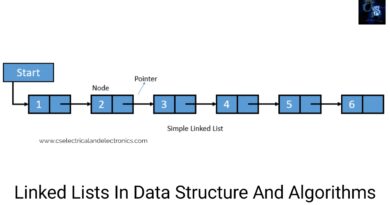Queue In Data Structure And Algorithm Using C, Code, Explanation,
Hello guys, welcome back to my blog. In this article, I will discuss queue in data structure and algorithm using c, code of queue in the data structure, types of queue, explanation with diagram, etc.
If you need an article on some other topics then comment us below in the comment box. You can also catch me @ Instagram – Chetan Shidling.
Also, read:
- Search In Data Structure, Linear, Binary, Explanation, Code, Algorithm.
- Linked List In Data Structure, Explanation, Algorithm, Code, Questions.
- Stack Operation In Data Structure, Definition, Code, Push, Pop, Full.
Queue In Data Structure

Assume we require to add another element by value 5, then REAR would be incremented by 1 and that value would be saved at the position pointed by REAR. The queue after addition would be as shown in block 02. Here, FRONT = 0 and REAR = 8. Each time a different element has to be added, we replicate the same procedure. If we need to delete a component from the queue, later the value of FRONT will be incremented. Deletions are made from just this end of the queue. The queue after deletion will be as shown in block 03.
Program to perform queue operation?
In this code, we can add a new element, delete an element, and we can also check whether the queue is full or empty, we can also display all elements.
#include <stdio.h>
#include <stdlib.h>
struct queue{
int size;
int f;
int r;
int * arr;
};
int isEmpty(struct queue *q){
if(q->r==q->f){
return 1;
}
return 0;
}
int isFull(struct queue *q){
if(q->r==q->size-1){
return 1;
}
return 0;
}
void enqueue(struct queue *q, int val){
if(isFull(q)){
printf("This Queue is full\n");
}
else{
q->r++;
q->arr[q->r]=val;
}
}
int dequeue(struct queue *q){
int a = -1;
if(isEmpty(q)){
printf("This Queue is Empty\n");
}
else{
q->f++;
a = q->arr[q->f];
}
return a;
}
int main()
{
int O, val;
struct queue q;
q.size = 100;
q.f = q.r = -1;
q.arr = (int*)malloc(q.size*sizeof(int));
printf("1: For Enqueue\n");
printf("2: For Dequeue\n");
printf("3: To check empty\n");
printf("4: To check full\n");
printf("5: Display\n");
printf("6: To exit\n");
while(q.r != q.size-1){
printf("Enter the operation you want to perform\n");
scanf("%d", &O);
switch(O)
{
case 1:
printf("Enter the element you want to store\n");
scanf("%d",&val);
enqueue(&q, val);
printf("Element is %d\n",q.arr[q.r]);
break;
case 2:
printf("Dequeueing element %d\n", dequeue(&q));
break;
case 3:
if(isEmpty(&q)){
printf("Queue is Empty\n");
}
else
printf("Not Empty\n");
break;
case 4:
if(isFull(&q)){
printf("Queue is Full\n");
}
else
printf("Not full\n");
break;
case 5:
printf("Display All Values Stored\n");
while(q.f!=q.r)
{
q.f++;
printf("Element are %d\n",q.arr[q.f]);
}
break;
default:
exit(0);
}
}
return 0;
}
Output:
1: For Enqueue
2: For Dequeue
3: To check empty
4: To check full
5: Display
6: To exit
Enter the operation you want to perform
1
Enter the element you want to store
22
Element is 22
Enter the operation you want to perform
1
Enter the element you want to store
44
Element is 44
Enter the operation you want to perform
1
Enter the element you want to store
66
Element is 66
Enter the operation you want to perform
4
Not full
Enter the operation you want to perform
3
Not Empty
Enter the operation you want to perform
2
Dequeueing element 22
Enter the operation you want to perform
5
Display All Values Stored
Element are 44
Element are 66
Enter the operation you want to perform
Types of queues
- Circular Queue
- Deque
- Priority Queue
- Multiple Queue
Applications Of Queue
01. Queues are generally used as waiting lists for a single shared device like a printer, disk, CPU.
02. Queues are utilized to transfer data asynchronously (data not necessarily received at the same rate as sent) between two processes (IO buffers), e.g., pipes, file IO, sockets.
03. Queues are employed as buffers on MP3 players and portable CD players, iPod playlist.
04. Queues are used in Playlist for the jukebox to add songs to the end, play from the front of the list.
05. Queues are used in the operating system for handling interrupts. When programming a real-time system that can be interrupted, for example, by a mouse click, it is necessary to process the interrupts immediately, before proceeding with the current job. If the interrupts have to be handled in the order of arrival, then a FIFO queue is the appropriate data structure.
I hope this article may help you all a lot. Thank you for reading.
Also, read:
- 100+ C Programming Projects With Source Code, Coding Projects Ideas
- 1000+ Interview Questions On Java, Java Interview Questions, Freshers
- App Developers, Skills, Job Profiles, Scope, Companies, Salary
- Applications Of Artificial Intelligence (AI) In Renewable Energy
- Applications Of Artificial Intelligence, AI Applications, What Is AI
- Applications Of Data Structures And Algorithms In The Real World
- Array Operations In Data Structure And Algorithms Using C Programming
- Artificial Intelligence Scope, Companies, Salary, Roles, Jobs
- AWS Lambda, Working, Cost, Advantages, Disadvantages
- AWS Technical Interview Questions, Top 200+ AWS Questions
- Battery Management Systems Using Artificial Intelligence
- Best Engineering Branch For Future
- Best Programming Languages For Electrical and Electronics Engineers
- Big Data, Evolution Of Big Data, Benefits Of Big Data, Opportunities
- Bit Operation In C Programming With Example & Applications
- Blockchain Projects For Computer Science Engineers
- Blockchain Technology, History, Working, Applications, Advantages
- Brain Computer Interfaces Technology, Beyond AI, ML, IoT, Blockchain
- C Language Interview Questions On Programs With Output
- C Program On Arrays With Output For Placement Exams
Author Profile
- Chetu
- Interest's ~ Engineering | Entrepreneurship | Politics | History | Travelling | Content Writing | Technology | Cooking
Latest entries
 All PostsApril 19, 2024What Is Vector CANoe Tool, Why It Is Used In The Automotive Industry
All PostsApril 19, 2024What Is Vector CANoe Tool, Why It Is Used In The Automotive Industry All PostsApril 13, 2024What Is TCM, Transmission Control Module, Working, Purpose,
All PostsApril 13, 2024What Is TCM, Transmission Control Module, Working, Purpose, All PostsApril 12, 2024Top 100 HiL hardware in loop Interview Questions With Answers For Engineers
All PostsApril 12, 2024Top 100 HiL hardware in loop Interview Questions With Answers For Engineers All PostsMarch 22, 2024Driver Monitoring Systems In Vehicles, Working, Driver Sleepy Alert
All PostsMarch 22, 2024Driver Monitoring Systems In Vehicles, Working, Driver Sleepy Alert








